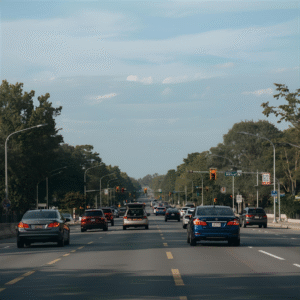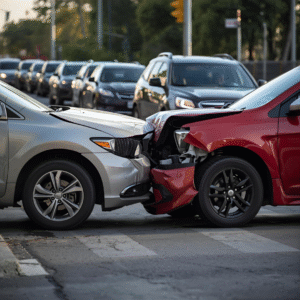Labor Day is often seen as the unofficial end of summer, a final chance for lake trips, backyard cookouts, and family getaways before school and fall routines settle in. But with that holiday excitement comes one of the busiest and most dangerous weekends on the road. The dreaded Labor Day traffic.
According to the National Safety Council, Labor Day weekend consistently ranks among the deadliest driving holidays in the U.S. With millions of drivers on the move, the risk of fender-benders, rear-end collisions, and serious accidents increases significantly.
At Hammer’s Autoworks, we see firsthand the aftermath of holiday travel accidents. While our job is to restore your vehicle to pre-accident condition, we’d rather you avoid the accident altogether.
With that in mind, here’s a deeper look at why Labor Day weekend poses unique driving hazards, and what you can do to stay safe behind the wheel.

Why Labor Day Traffic Is So Intense
Several factors combine to make Labor Day one of the most hazardous weekends of the year for drivers:
- High Traffic Volume – The highways are packed as families travel long distances for one last summer adventure. More cars on the road means less room for error.
- Longer Trips – Many families drive several hours or across state lines. Long stretches on the road can cause driver fatigue and slower reaction times.
- Late-Night Driving – Returning home after fireworks, parties, or lake weekends increases the chance of encountering drowsy or impaired drivers.
- Impatience and Speeding – Everyone wants to “just get there.” Aggressive lane changes and tailgating become more common.
- Holiday Mindset – People are focused on fun, not safety. Distractions like phones, GPS reroutes, or wrangling kids in the back seat add extra risk.
Smart Tips for Safer Labor Day Travel
The good news is that preparation and awareness can dramatically reduce your risk of an accident. Here are some practical tips:
1. Plan Ahead and Give Yourself Time
Leave earlier than you think you need to. Not only will you avoid peak congestion, but you’ll feel less pressure to speed or weave through traffic. Check road conditions and construction updates before you leave.
2. Buckle Up Every Time
It seems obvious, but many serious injuries in crashes happen because someone wasn’t wearing a seatbelt. Make buckling up non-negotiable for every passenger, every trip — even quick runs to the store.
3. Avoid Distractions
Texting and driving is a leading cause of accidents. Put your phone on “Do Not Disturb” mode or let a passenger handle GPS and music. Even looking away for two seconds at highway speeds can mean traveling the length of a football field without seeing what’s ahead.
4. Rest and Rotate Drivers
Drowsy driving slows reaction times and impairs judgment, just like alcohol. If your trip is longer than a few hours, plan breaks. Switch drivers if possible, and don’t push yourself to “just make it there” if you’re tired.
5. Watch Your Speed and Following Distance
Holiday drivers often tailgate in frustration, but that’s how rear-end collisions happen. Keep a safe distance, especially in heavy traffic. Remember: the faster you go, the harder the impact if something goes wrong.
6. Prepare for the Unexpected
Anticipate lane changes, sudden braking, and aggressive drivers. Defensive driving isn’t about being scared — it’s about staying prepared.
Vehicle Readiness Before the Trip
While Hammer’s Autoworks doesn’t perform mechanical services, we know that a car in poor condition is more likely to contribute to an accident. Before hitting the road:
- Check Lights: Make sure headlights, brake lights, and turn signals are working for visibility.
- Inspect Wipers & Windshield: Clear vision prevents accidents, especially if late-summer storms pop up.
- Tires: Bald or underinflated tires can cause blowouts or skids.
- Mirrors & Windows: Clean them to reduce blind spots.
These simple checks can reduce your risk of being in a collision in the first place.

What to Do If an Accident Happens
Even the most careful drivers can find themselves in an accident on a busy holiday weekend. Here’s what to do:
- Check for Injuries First – Safety comes before vehicle damage. Call 911 if anyone is hurt.
- Move to Safety – If possible, pull your vehicle to the shoulder to avoid secondary crashes. Turn on hazard lights immediately.
- Stay Calm – Holiday stress can make tempers flare. Stay polite and avoid placing blame at the scene.
- Document Everything – Take photos of all vehicles, license plates, and the accident scene. This will be critical for insurance and repairs.
- Exchange Information – Get names, phone numbers, insurance, and driver’s license details from everyone involved.
- File a Police Report if Needed – Especially important if there are injuries or significant damage.
- Contact Your Insurance Company – Report the accident as soon as possible.
- Choose the Right Body Shop – Remember, you have the right to choose where your vehicle is repaired. Hammer’s Autoworks works directly with insurance companies to ensure repairs are safe, accurate, and up to OEM standards.
The Importance of Quality Repairs After a Holiday Accident
If your vehicle sustains body damage during Labor Day weekend, don’t let rushed or cut-corner repairs put you at risk. Using aftermarket parts or improper repair methods can compromise your car’s structural integrity and safety features.
At Hammer’s Autoworks, we only use OEM-certified methods to restore your vehicle. That means if your car is in another accident in the future, its crumple zones, airbags, and safety systems will perform as designed.
Final Thought
Labor Day should be about relaxing with family and friends — not dealing with the aftermath of a collision. By planning ahead, staying alert, and making smart decisions on the road, you can reduce your risk of an accident and keep your weekend stress-free.
And if the unexpected does happen? Know that Hammer’s Autoworks is here to work with your insurance company and restore your vehicle safely and correctly, so you can get back to life with peace of mind.

